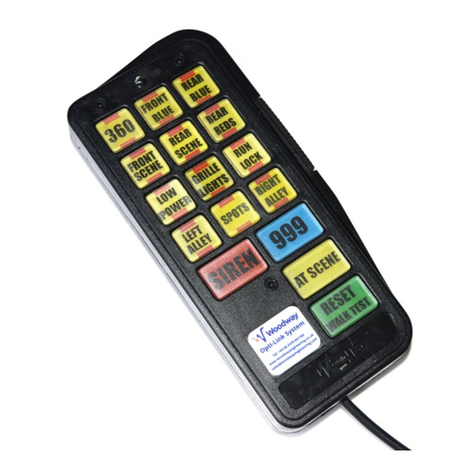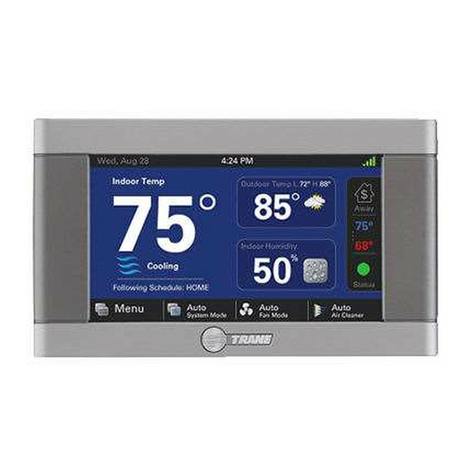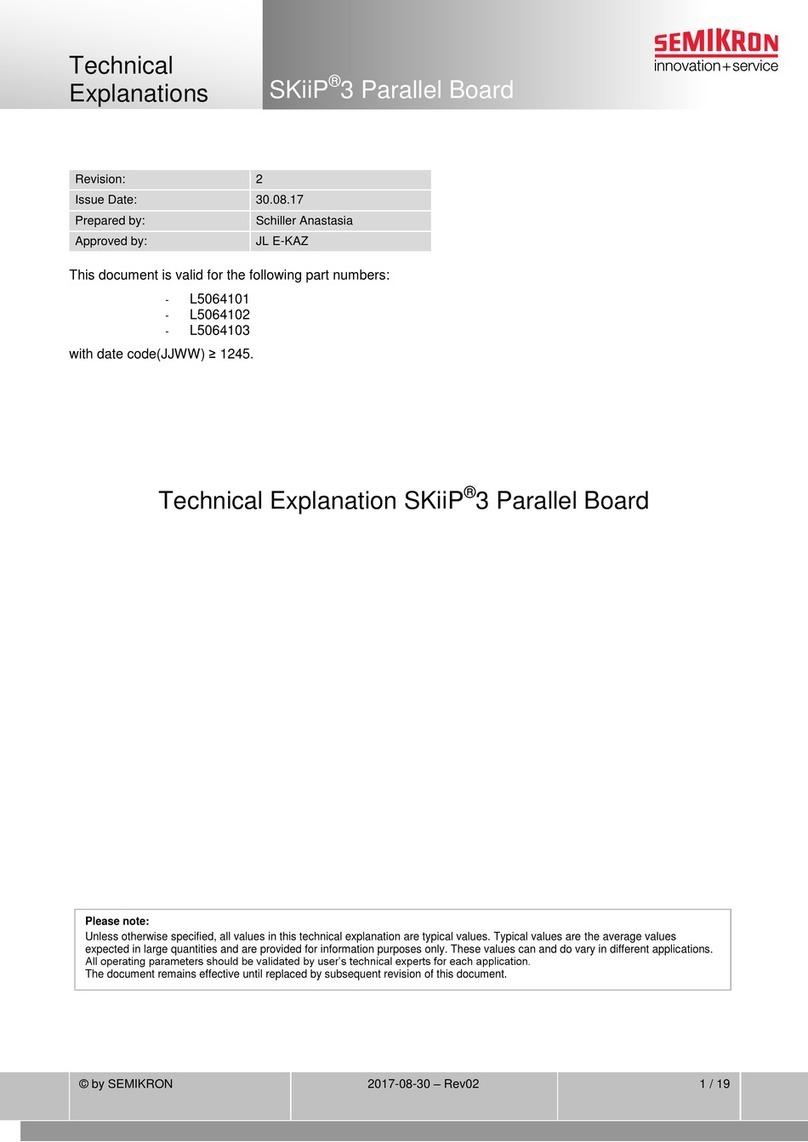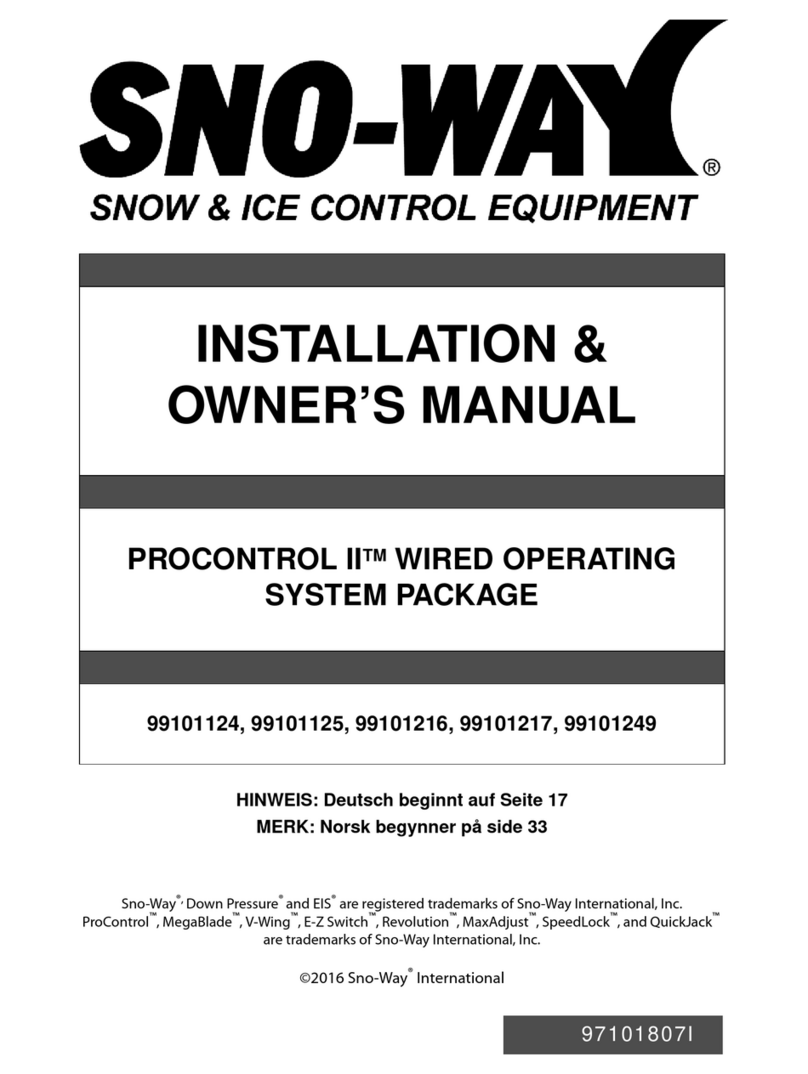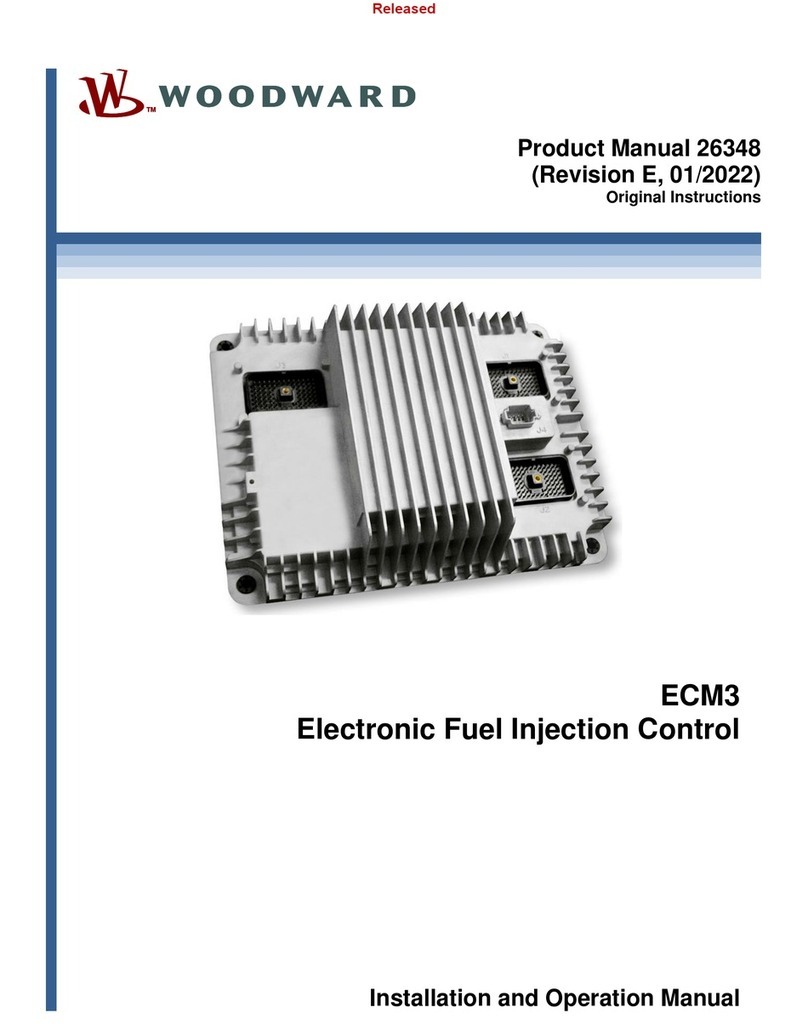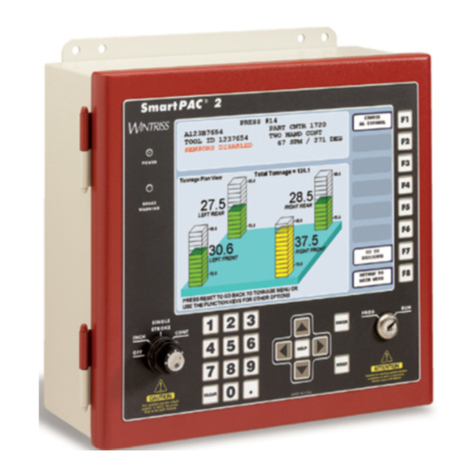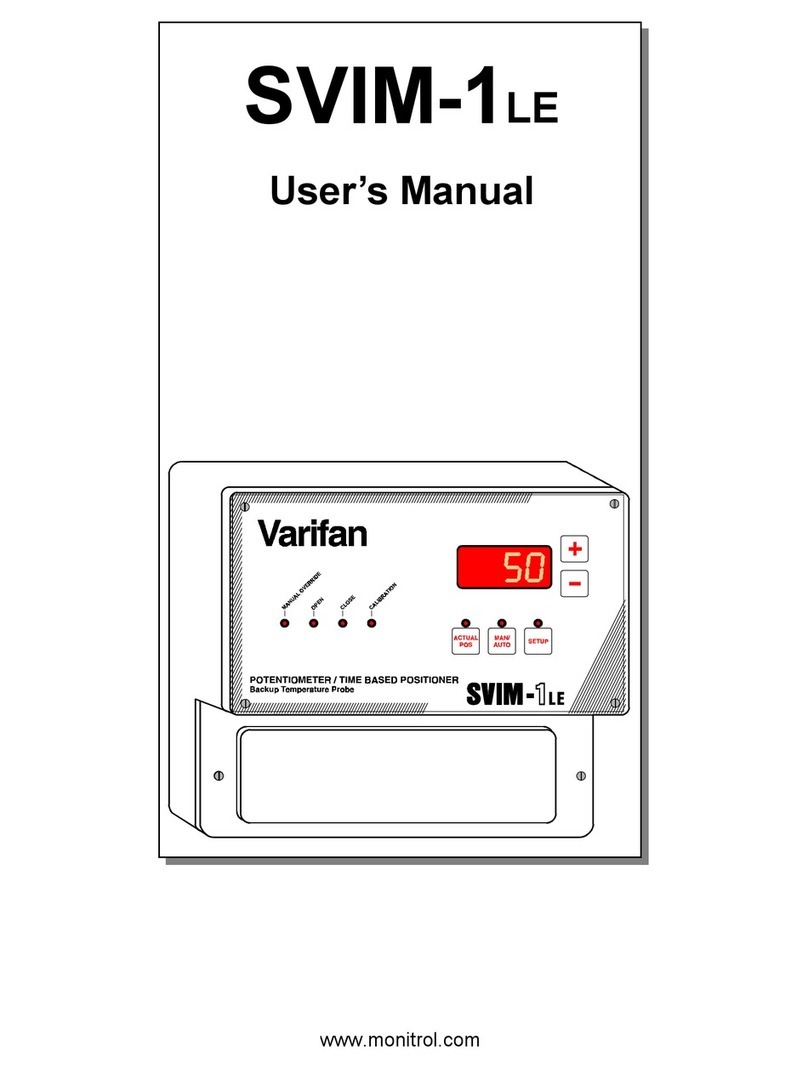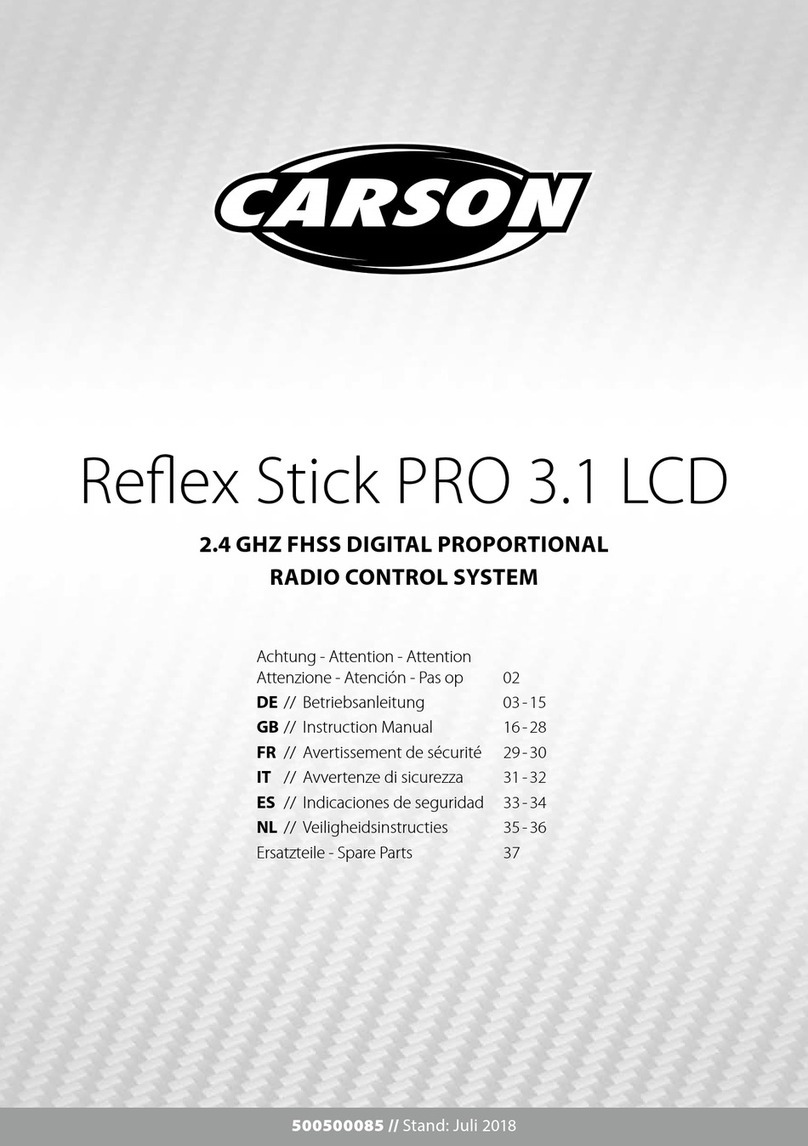Nivetec Echo Smart Series User manual

Operation & Installation
M a n u a l
Version A2.1
Echo Smart Sensor
Echo Smart Controller
Echo Smart Power Supply Unit


- Page i -
Table of Contents
Table of Contents............................................................................................................................i
Safety Precautions...........................................................................................................................v
1. Product Description......................................................................................................... 1
1.1. Stand-Alone Instrument Option...............................................................................................1
1.2. Field Network Option................................................................................................................1
1.3. Network Integrated to Customer Data Acquisition and Controls........................................1
2. Applications........................................................................................................................ 2
2.1. Wastewater and Water Treatment Clarifiers and Thickeners .............................................2
2.2. Industrial Wastewater and Raw Water Treatment ...............................................................2
2.3. Industrial Process Applications................................................................................................2
3. EchoSmart Sensor (ESS)................................................................................................ 3
3.1. General Overview......................................................................................................................3
4. EchoSmart Controller –Graphical User Interface (ESC) ....................................... 4
4.1. General Overview......................................................................................................................4
4.1.1. Operator Interface Overview (Figure 4.1)........................................................................................4
4.1.2. Keypad.................................................................................................................................................5
4.2. Power, Cabling, and General Electrical Connections for the ESC.......................................5
4.2.1. Power Requirements ..........................................................................................................................6
4.2.2. Connections Overview (Figure 4.2 and Table 4.1)...........................................................................6
4.3. Utilization of Informational Displays.......................................................................................9
4.3.1. Echo Profile Display (Figure 4.3) ......................................................................................................9
4.3.2. Sensor Register Displays (Figure 4.4 and 4.5)................................................................................10
4.3.3. Tank View Display (Figure 4.6).......................................................................................................11
4.3.4. Historical Trend Display (Figure 4.8).............................................................................................12
4.3.5. Modify Settings Display (Figure 4.9)...............................................................................................12
4.3.6. Advanced Settings Display (Figure 4.11)........................................................................................14
4.3.7. Controller Setup Display (Figure 4.12)...........................................................................................14
4.3.8. Sensor Selection Drop-down Window (Figure 4.14)......................................................................16
4.4. Initializing and Configuring Controller and Smart Sensor(s) ............................................16
4.4.1. Initial Controller Setup Display (Figure 4.15) ...............................................................................16
4.4.2. First Time Controller & Sensor System Installation (Figure 4.16 and 4.17)...............................17
4.4.3. Replacing a Controller with Existing Sensor(s) (Figure 4.15) .....................................................18
4.5. Automatic Initialization and Reboot Sensor.........................................................................19
5. EchoSmart Power Supply Unit (ESP)........................................................................ 20
5.1. Power, Cabling, and General Electrical Connections for the ESP .....................................20
5.1.1. Power Requirements ........................................................................................................................20
5.1.2. Connections Overview (Figure 5.1 and Table 5.1).........................................................................20
6. Installation of Equipment.............................................................................................. 23

- Page ii -
6.1. Installation of EchoSmart Sensor ..........................................................................................23
6.2. Sensor Location Selection Criteria.........................................................................................25
6.2.1. Acceptable Process Liquid...............................................................................................................25
6.2.2. Responsive Interface Material.........................................................................................................25
6.2.3. Stationary Objects in Path of Transmit Pulse................................................................................25
6.2.4. Areas of Excessive Air/Gas Bubbles and Turbulence....................................................................25
6.2.5 Typical Circular Clarifier Installation (Figure 6.2).......................................................................26
6.2.6 Typical Rectangular Clarifier Installation .....................................................................................27
6.2.7 Installing Sensors in Applications with Surface Skimmers...........................................................27
6.3. Installation of EchoSmart Controller and EchoSmart Power Supply Unit.......................27
7. Tank Configuration, Waveform Analysis, and Tracking....................................... 30
7.1. Tank Configuration (Figure 7.1)............................................................................................30
7.2. Waveform Analysis (Figure 7.2).............................................................................................30
7.3. Tracking...................................................................................................................................31
7.3.1. Gate....................................................................................................................................................31
7.3.2. Signal Waveform Symbols...............................................................................................................32
8. Communications, Outputs, and Networking ........................................................... 33
8.1. Configuration of Individual Units and Networks.................................................................33
8.1.1. Stand-Alone Instrument (Figure 8.1)..............................................................................................33
8.1.2. Wired RS-485 Field Network (Figure 8.2)......................................................................................34
8.1.3. Wireless Radio Frequency (RF) Field Network (Figure 8.3) ........................................................35
8.1.4. Integrated Field Networks (Figure 8.4) ..........................................................................................36
8.2. Outputs.....................................................................................................................................36
8.2.1. RS-485 Modbus RTU .......................................................................................................................37
8.2.2. Analog 4-20 mA Current Loop........................................................................................................37
8.3. Communication Options and Facilities .................................................................................37
8.3.1. RS-485 Modbus RTU Communication...........................................................................................37
8.3.2. Local RS-232 Serial Communication..............................................................................................37
8.3.3. Factory Remote Service ...................................................................................................................38
9. Instrument Programming Parameters....................................................................... 40
9.1. Modify Settings Display Parameters......................................................................................40
9.1.1. Units (ft).............................................................................................................................................40
9.1.2. Tank Depth (10.0).............................................................................................................................40
9.1.3. Zero Adjust (0.5)...............................................................................................................................40
9.1.4. Min Range (3.0).................................................................................................................................41
9.1.5. Auto Gain (ON).................................................................................................................................41
9.1.6. Current Gain (30).............................................................................................................................41
9.1.7. AG Set Point (Auto Gain Set Point) (10) ........................................................................................41
9.1.8. Update Rate (10)...............................................................................................................................41
9.1.9. Interface (First).................................................................................................................................41
9.1.10. Dampening (130)...............................................................................................................................42
9.1.11. Settling Zone (ON) ............................................................................................................................42
9.1.12. Tank Display (ON)............................................................................................................................42
9.1.13. Trend Display (ON) ..........................................................................................................................42
9.1.14. Display Contrast (55)........................................................................................................................42
9.2. Advanced Settings Display Parameters.................................................................................43
9.2.1. Max Range (11.0)..............................................................................................................................43

- Page iii -
9.2.2. Measure (Level).................................................................................................................................43
9.2.3. Wiper Timing (240)..........................................................................................................................43
9.2.4. Gain Band (20)..................................................................................................................................43
9.2.5. Gain Increment (0.1) ........................................................................................................................43
9.2.6. Save GB Midpoint (MP) (OFF) .......................................................................................................43
9.2.7. GB Midpoint (Automatically set)......................................................................................................44
9.2.8. Wall Zone (0.5)..................................................................................................................................44
9.2.9. Wall Zone AG (40)............................................................................................................................44
9.2.10. Sound Speed (4862 fps).....................................................................................................................44
9.2.11. Sensitivity (20)...................................................................................................................................44
9.2.12. LG Min (2.0)......................................................................................................................................45
9.2.13. RG Min (2.0) .....................................................................................................................................45
9.2.14. 4mA Set Point (0.0)...........................................................................................................................45
9.2.15. 20mA Set Point (10.0).......................................................................................................................45
9.2.16. Echo Loss (OFF) ...............................................................................................................................45
9.2.17. Echo Delay (60).................................................................................................................................45
9.2.18. Echo Loss Action (Cycle)..................................................................................................................45
10. Maintenance and Troubleshooting ............................................................................ 47
10.1. Preventative Maintenance ......................................................................................................47
10.1.1. Sensor Cleaning and Maintenance..................................................................................................47
10.1.2. Other Routine Maintenance ............................................................................................................48
10.2. Troubleshooting.......................................................................................................................49
10.2.1. Comm Error Message ......................................................................................................................49
10.2.2. Echo Loss Message ...........................................................................................................................49
10.2.3. Validating Message...........................................................................................................................49
10.2.4. Validation Failure Message .............................................................................................................49
10.2.5. Wiper Stalled Message.....................................................................................................................50
10.2.6. Wiper Motor Failure Message.........................................................................................................50
10.2.7. 4-20 mA Measurement Discrepancy ...............................................................................................50
10.2.8. Sensors Not Detected and No Sensors Found Message .................................................................50
10.2.9. Troubleshooting Radio Communications.......................................................................................51
10.2.10. Persistent “Acquiring Waveform” Message on Echo Profile Screen ...........................................51
11. System Options............................................................................................................... 52
11.1. Self-Cleaning Wiper Sensor with Turbidity Measurement................................................52
11.1.1. Application........................................................................................................................................52
11.1.2. Principle of Operation......................................................................................................................52
11.1.3. Sensor Cleaning ................................................................................................................................52
11.1.4. Installation.........................................................................................................................................52
11.1.5. Connections.......................................................................................................................................53
11.1.6. Turbidity Sensor Calibration ..........................................................................................................53
11.2. Integrated Wireless Radio (RF) Modules..............................................................................53
11.2.1. General Overview.............................................................................................................................53
11.2.2. Internal Configuration.....................................................................................................................53
11.2.3. External Configuration....................................................................................................................54
11.2.4. Equipment Orientation for Units with Integrated Wireless Radio Modules...............................55
11.3. Relays........................................................................................................................................56
11.3.1. General Overview.............................................................................................................................56
11.3.2. Operation (Figure 11.3)....................................................................................................................56
11.3.3. Cabling and Connections for Relays (Figure 11.4 and Table 11.1)..............................................57
12. Warranty............................................................................................................................ 58

- Page iv -
13. Quick Start Guide............................................................................................................ 59
13.1. Configuring a Single Sensor...................................................................................................59
13.2. Configuring a Sensor Network...............................................................................................60
13.3. Special Settings for Filter Applications .................................................................................63

- Page v -
Safety Precautions
About this Manual: PLEASE READ THE ENTIRE MANUAL PRIOR TO
INSTALLING OR USING THIS PRODUCT.
The following safety precautions should be observed in the implementation and use of this
product.
The EchoSmart Controller (ESC), EchoSmart Power Supply Unit (ESP), and EchoSmart
Sensor (ESS) are intended for use by qualified personnel who recognize shock hazards and
are familiar with the safety precautions required to avoid possible injury. Read the operating
information carefully before using the product.
User’s Responsibility for Safety:
Responsible body: this is the individual or group responsible for the use and maintenance of
equipment, and for ensuring that operators are adequately trained. Operators are to use the
product for its intended function. They should not be allowed access to the electrical
connections within the control box, and would normally only operate the external keypad
and monitor the display.
Maintenance personnel perform routine procedures on the product to keep it operating, for
example, checking the line voltage or checking electrical connections, replacing main fuses,
etc. Only service personnel should perform other tasks.
There are no user serviceable parts on the main PCB section of the EchoSmart ESC or ESP.
Service personnel are trained to work on live circuits, and perform safe installations and
repairs of products. Only properly trained service personnel may perform installation and
service procedures.
Wiring and Electrical: Users of this product must be protected from electric shock at all
times. The responsible body must ensure that users are prevented access and/or insulated
from every connection point. Product users must be trained to protect themselves from the
risk of electric shock.
Before operating an instrument, make sure the line cable is connected to a properly grounded
power receptacle. Inspect the connection cables for possible wear, cracks, or breaks before
each use. When fuses are used in a product, replace with same type and rating for continued
protection against fire hazard.
For CE and safety compliance, adequate grounding and shielding is required. All
EchoSmart system cables are to be installed in metal conduit that is properly grounded and
shielded utilizing EMC compliant methods. Each conduit should be individually shielded
and grounded. Where metal enclosures are supplied, each enclosure should be grounded and
shielded to each individual conduit.
External chassis components can not be used as safety earth ground connections.

- Page vi -
Standard fuses, with applicable national safety approvals, may be used if the rating and type
are the same. If you are unsure about the applicability of a replacement component, call
Entech Design for information. Only use the EchoSmart ESC or ESP with the sensor
supplied. Replace Fuse with: 1.25A 5x20mm T-Lag UL approved.
This equipment is suitable for use with 110-240 Volts AC power at 50-60 Hz. No internal
changes are required within this range. Equipment is optionally available and can be ordered
for use with 24VDC power. Caution must be taken to supply main power in the form for
which the equipment is designed.
A protective earth should be provided for all installations.
WARNING
If this equipment is used in a manner not specified by Entech Design, the protection provided
may be impaired. The EchoSmart ESC, ESP, and ESS are regarded as permanently installed
equipment and as such a switch or circuit breaker must be included in the installation. This
should be in close proximity to the equipment, it should be marked as the disconnecting
device, and it should disconnect both current carrying conductors.
WARNING
CHECK THAT THE POWER SUPPLY IS SUITABLE BEFORE SWITCHING POWER
ON.
Proper Installation and Handling: The normal application for the EchoSmart ESC or
ESP requires it to be installed at industrial installations including water and wastewater
treatment plants. While the ESC and ESP enclosures are liquid-resistant (IP65), they are not
designed to be immersed. These items should be mounted in such a way that the enclosure
does not come into contact with the application media under normal operational conditions.
The ESS (sensor) and its cabling are designed to be submerged without hazard to the
equipment or to operators when correctly connected as described in this manual.
To clean the instrument, use a damp cloth or mild, water based cleaner. Clean the exterior
of the instrument only. Do not apply cleaner to the inside of the instrument or allow liquids
to enter or spill on the instrument.
Material Compatibility: The ESC and ESP enclosures are made of flame retardant
Polycarbonate (PC/ABS FR). The ESS enclosure is made of epoxy-filled ABS. Some sensor
models include additional wetted parts. Make sure that the model which you have selected
is chemically compatible with the application media, temperatures, and pressures to which it
will be exposed.

- Page vii -
WARNING WHEN APPLICABLE
This equipment complies with FCC radiation exposure limits set forth for an uncontrolled
environment. This equipment should be installed and operated with minimum distance 20cm
between the radiator and your body. This transmitter must not be co-located or operating in
conjunction with any other antenna or transmitter.

- Page 1 -
1. Product Description
EchoSmartis an exciting new development in liquid/solid interface level analyzers.
Instruments employ digital sensors in an architecture that locates microprocessor signal
control, enhancement and interpretation in the ultrasonic sensor rather than in a remote
analyzer. The sensor is a Smart device. When connected to a power source and instrument
programmer (typically EchoSmart Controller or EchoSmart Power Supply Unit), it produces
the Level or Range measurement and an indication of the dispersed solids Level above the
primary interface. Optional sensors are available that additionally provide surface back
scatter turbidity measurements.
This equipment design opens the door for a wide range of flexible installation configuration
options. The Controller is the operator graphical user interface device and power source to a
sensor. It is also a communication hub for analog and digital communication outputs to the
customer data acquisition system. EchoSmart can be implemented as a stand-alone
instrument (Controller + Smart Sensor) or with numerous sensors networked together and
operated by a single Controller as discussed below.
1.1. Stand-Alone Instrument Option
When connected to an EchoSmart Controller, the instrument has all the functionality
of a complete measurement system. The Controller provides power to the sensor and
is the user interface for instrument programming and communication with the sensor.
Customer terminations for digital and analog communications to the customer’s data
acquisition and control system are provided inside the Controller.
A large graphical LCD with control keypad provides a simple and intuitive platform to
implement Sensor Parameters, configure communications, view current and historical
measurements, and perform system diagnostics. HELP PROMPTS are automatically
displayed for each parameter and system function.
1.2. Field Network Option
Up to 16 EchoSmart Sensors can be operated by a single Controller in a wired or
wireless Field Network. In either arrangement, the network is fully integrated and
requires no software integration by the customer.
The Controller handles all programming and monitoring functions for all sensors in the
network. Power Supply Units provide power to associated sensors and are fitted with
integrated two-way transmitter modules when used in an RF network. Terminations for
analog communication (4-20mA signal) are also at the Power Supply Unit.
1.3. Network Integrated to Customer Data Acquisition and Controls
EchoSmart Field Networks can be integrated to the customer’s data acquisition and
control system via two-wire RS-485, Modbus RTU protocol. See Section 8.4 for
additional information.

- Page 2 -
2. Applications
EchoSmart is suitable for most municipal and industrial liquid/solid separation processes in
which a reliable measurement of the level of a solids or suspended-solids blanket is desired.
Typical applications include municipal and industrial wastewater and water treatment
clarifiers and gravity thickeners. Sensors with optional turbidity measurement are available
for applications in which a 0-50 NTU turbidity indication at the location of the sensor is
desired. A broad range of industrial process applications are also appropriate. Self-cleaning
sensors and special design sensors to accommodate high temperature and exposure to
chemical environments are available.
2.1. Wastewater and Water Treatment Clarifiers and Thickeners
EchoSmart instruments are most frequently implemented to provide reliable sludge
blanket level measurements in municipal wastewater and water treatment operations.
Instruments are suitable for circular and rectangular basins, uncovered and covered
tanks, and those with both fixed and traveling bridge arrangements. Mounting
arrangements easily accommodate surface skimmers and rakes. Automatic signal
control functions adapt to differences in sludge density that typically occur in primary,
secondary and final clarifiers, and gravity thickeners.
Instruments are also effective in granular media gravity and pressure filters for
conditional backwash control. Measurements include media level and expansion, and
above filter turbidity (backwash turbidity).
2.2. Industrial Wastewater and Raw Water Treatment
EchoSmart is effective in providing sludge level measurements in a wide range of
industrial water treatment applications. Raw water from a surface water source is often
sent to a clarifier for particulate removal prior to introduction to plant processes. Water
spent in plant processes often requires primary, and even secondary treatment prior to
being directed to a municipal plant for further processing or being discharged in the
environment. EchoSmart sludge level measurements can be used to effectively control
clarifier solids blow-down, optimize chemical application, and limit solids discharge
in the effluent stream.
2.3. Industrial Process Applications
Suitable process applications are found in the Power Generation, Mining and Mineral
Processing, Chemical, Pulp and Paper and other process industries. Contact Entech
Design or an authorized representative for further information on the characteristics
and requirements for successful implementation of EchoSmart equipment in these
environments.

- Page 3 -
3. EchoSmart Sensor (ESS)
The EchoSmart Sensor is a microprocessor controlled piezoelectric transducer designed
specifically for operation under water (submerged in the process liquid).
3.1. General Overview
The EchoSmart Sensor generates an ultrasonic sound wave that propagates through a
liquid medium and is reflected back from material that is present in the vessel (typically
settled solids, suspended solids, and/or the tank bottom). The sound wave travels at
known velocities providing the ability to convert elapsed time into Range and Level
measurements.
The EchoSmart Sensor does more than just produce a raw signal. It is equipped with
an advanced programmable microprocessor and dynamic memory. Through these
facilities, the sensor provides all signal control, enhancement and interpretation, and
determines the final process measurement. The Smart Sensor communicates with an
EchoSmart Controller via digital communication. The sensor also generates a 4-20 mA
proportional current loop signal. Customer connections are provided at the Controller.
If a Smart Sensor is part of a field network, connections are made at the Controller or
Power Supply Unit that is supplying power to the sensor.
Sensors with a 90◦ surface back-scatter turbidity meter integrated into the ESS are
available. This option can be beneficial and cost effective in applications where a
turbidity measurement at the location of the sensor is desired. It is often used in
secondary clarifiers and similar applications to alert process upset conditions. It is also
employed in water and wastewater treatment media filters as part of an effective
conditional backwash control system.

- Page 4 -
4. EchoSmart Controller –Graphical User Interface
(ESC)
The EchoSmart Controller allows for programming and local monitoring of one to sixteen
EchoSmart Sensors.
4.1. General Overview
The Controller display consists of a graphical backlit LCD (2.6 x 3.45 inch viewing
area) that is divided into five functional sections. Soft Keys and Navigation Keys
located to the right of the screen are used for data entry and other operations. Figure
4.1 points out the functional sections of the screen and the location of the Soft Keys
and Navigation Keys.
Figure 4.1: The LCD Display
4.1.1. Operator Interface Overview (Figure 4.1)
The display has five informative sections:
Smart Sensor Name & Address
The bar at the top of the display shows the name and network address that has been
assigned to the sensor. This is the sensor that is currently being interrogated.
Information on this and all other displays relates to this sensor.
If the Controller is operating a multi-sensor field network, other sensors are
available by pressing the Change Sensor soft key. A listing of network sensors will
appear (See Figure 4.12). Use the Navigation Keys to select the desired sensor and
press Select Sensor.
Sensor Name & Address
Current Measurement
and Operating Gain
“Help Prompts” Field
Soft Key
Prompts
Soft Keys
Navigation
Keys
Main Display Area

- Page 5 -
Current Measurement and Operating Gain
The current measurement, operating gain (signal amplification), and turbidityvalue
(when applicable) are conveniently available in the lower left corner of all displays.
Additionally, messages regarding external communication (see Sections 8.3 and
8.5) taking place and error messages (see Section 10.2) associated with the active
sensor are displayed in this section.
Help Prompts Field
The Help Prompts Field across the lower section of each display provides an
explanation of the screen, or the highlighted parameter. Help Prompts reduce the
need for reference to the print operating manual.
Main Display Area
The area has both digital and graphical capabilities. The content changes with the
functionality of the selected display.
Soft Key Prompts
The vertical bar on the right side of the display consists of four boxes. Each box
contains text that describes the function of the Soft Key that is located next to that
box. The text changes when the user selects a different function or navigates to a
different instrument parameter.
4.1.2. Keypad
The Echo Smart Controller has four Soft Keys and four Navigation Keys.
Soft Keys
The function of a Soft Key is described by the Soft Key Prompt located
immediately to the left of the key. Soft Keys are used to change instrument settings,
switch to a different display, or trigger other actions.
When using a soft key to increase or decrease a value, the key can be held down in
order to quickly modify the value.
Navigation Keys
Navigation Keys advance the instrument cursor to the desired location on the
display for operation by Soft Key commands.
4.2. Power, Cabling, and General Electrical Connections for the ESC
This section pertains to the physical layout of the Controller terminal connectors and
how they are connected as a stand-alone system. If you are wishing to network the
Controller with other devices (Ex: ESP, SCADA Systems, etc), see Section 8 for
sample connection diagrams.

- Page 6 -
4.2.1. Power Requirements
100-240 VAC, 50/60 Hz –1.5A
Supply cable: 10-18 AWG, -40 to +140 F
65 W (fused) 1.25A 250V 5x20mm T-lag UL approved fuse
4-20 mA Current Loop: 15 –24 VDC (provided by ESC)
Optional: 24 VDC (19 –42 VDC Input)
Caution must be taken to supply main power in the form for which the equipment
is designed.
4.2.2. Connections Overview (Figure 4.2 and Table 4.1)
The ESC circuit board contains four screw-terminal connectors as well as additional
plug-in connectors as shown in Figure 4.2. Use caution in tightening the screw
terminals to prevent damage from over-tightening.
Ensure the power cable (10-18 AWG) is connected to the power connector
properly. A breaker should be installed to fully remove power from the unit in the
event that repairs to the unit are required. Sensors (ESS) should be connected to
the controller by color code as shown in Figure 4.2 below. Table 4.1 contains a
functional description of the screw terminal connectors.

- Page 7 -
Figure 4.2: Connections for Controller
L G N
J10
J7
Red
Black
White
Brown
Yellow
Blue
Orange
Green
1
8
1
3
Sensor Connections
Power
Connector
(120/240 VAC)
* FOR 24 VDC *
4-20 mA
Connectors
1
4
Level
Turbidity
_
+
+
_
RS-485
1
3
_
+
S
External USB
(Future)
USB
(Future)
RS-232
Laptop /Cellular
Ethernet
(Future)
RF Module
Connector
(optional)
J1
Cell Modem
Power
J9
J18
J11
Relays
J4
J17
+ ––
LEDs
Aux
Data
RS-232
Data

- Page 8 -
Table 4.1: Connections
Power
Connector
(J1)
4-20 Analog
Connectors
(J10)
Sensor
Connections
(J9)
RS-485
Connector
(J7)
Pin #
Description
Pin #
Description
Pin #
Description
Pin #
Description
1
Live
1
Level +
1
15 V
1
Sensor
Comm
2
Ground
2
Level –
2
Ground
2
Sensor
Comm
3
Neutral
3
Turbidity +
3
Sensor
Comm (+)
3
Ground
4
Turbidity –
4
Sensor
Comm (–)
* FOR 24 VDC *
(J1)
5
4-20mA
Level
1
+
6
4-20mA
Level
2
–
7
4-20mA
Turbidity
3
–
8
4-20mA
Turbidity
Notes: Sensor Connector (J9): Use Pin 3 and Pin 4 to link the Sensor
Communication cable from the Controller to the next Power Supply Unit
in a Wired RS-485 Field Network. Conductors are ganged with those from
the sensor. Connection at the associated Power Supply Unit is at the RS-
485 Connector (J8).
RS-485 Connector (J7): Use this connector when integrating a Field
Network to the customer data acquisition and control system. This is the
communication link between the Controller and an outside device. It is not
used to interconnect Controllers and Power Supply Units.
4-20mA current loops are internally powered, grounded, and galvanically
isolated.

- Page 9 -
4.3. Utilization of Informational Displays
The Controller has four informational displays: Echo Profile Display, Sensor Register
Display, Tank View Display, and Historical Trend Display. Selections are made by
pressing the Change Display Soft Key. At power up, the system defaults to the Echo
Profile Display.
There are also three displays that are used to enter instrument settings: Modify Settings
Display, Advanced Settings Display and Controller Setup Display.
4.3.1. Echo Profile Display (Figure 4.3)
The Echo Profile Display shows the echo waveform generated by the selected
sensor. To view the waveform of another sensor, press the Change Sensor soft key,
select the desired sensor from the dropdown list, and press Select Sensor.
Figure 4.3: Echo Profile Display
This display presents the actively updated signal waveform generated by the sensor
and used to determine the Level or Range measurement.
The horizontal x-axis is a distance axis based on the span between the sensor (lower,
left side of the screen) and the bottom of the tank (lower, right side of the screen).
The vertical y-axis corresponds to the strength of signal at locations between the
sensor and the tank bottom. EchoSmart proprietary interpretive algorithms are
applied to the signal waveform to determine the position of an interface –typically
between a supernatant liquid and settled solids or suspended solids.
Sensor
Tank Bottom Indicator
Echo Profile (waveform)

- Page 10 -
4.3.2. Sensor Register Displays (Figure 4.4 and 4.5)
This display consists of a table that shows the name of each sensor and its Current
Measurement and Operating Gain value. If the Controller is communicating with
four or fewer sensors, information is presented as shown in Figure 4.4.
Figure 4.4: Four Sensor Field Network Display
With five or more sensors, information is presented as shown in Figure 4.5.
Figure 4.5: Multiple Sensor Field Network Display
These displays are not available when only one sensor is in use.

- Page 11 -
4.3.3. Tank View Display (Figure 4.6)
The Tank View Display shows a scaled cross-sectional view of the tank. The arrow
on the left side of the tank provides a visual indication of the current fill Level.
Dispersed solids that may be indicated in the echo waveform are represented by
pixilated gradients above the primary interface.
Figure 4.6: Tank View Display
The Tank View Display is enabled at the Modify Settings Display. Optional
diagrams are available to correspond with the specific application (Figure 4.7).
Figure 4.7: Tank Options
Table of contents
Popular Control System manuals by other brands
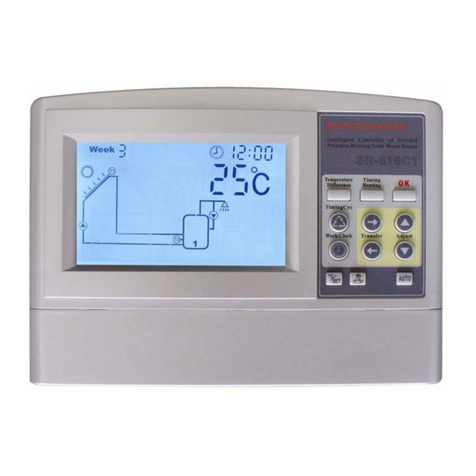
Shuangri Electric
Shuangri Electric SR618C1 Installation and operating manual
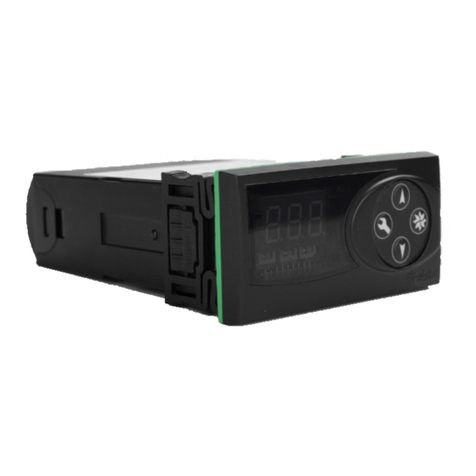
Elstat
Elstat ems25 Series product manual
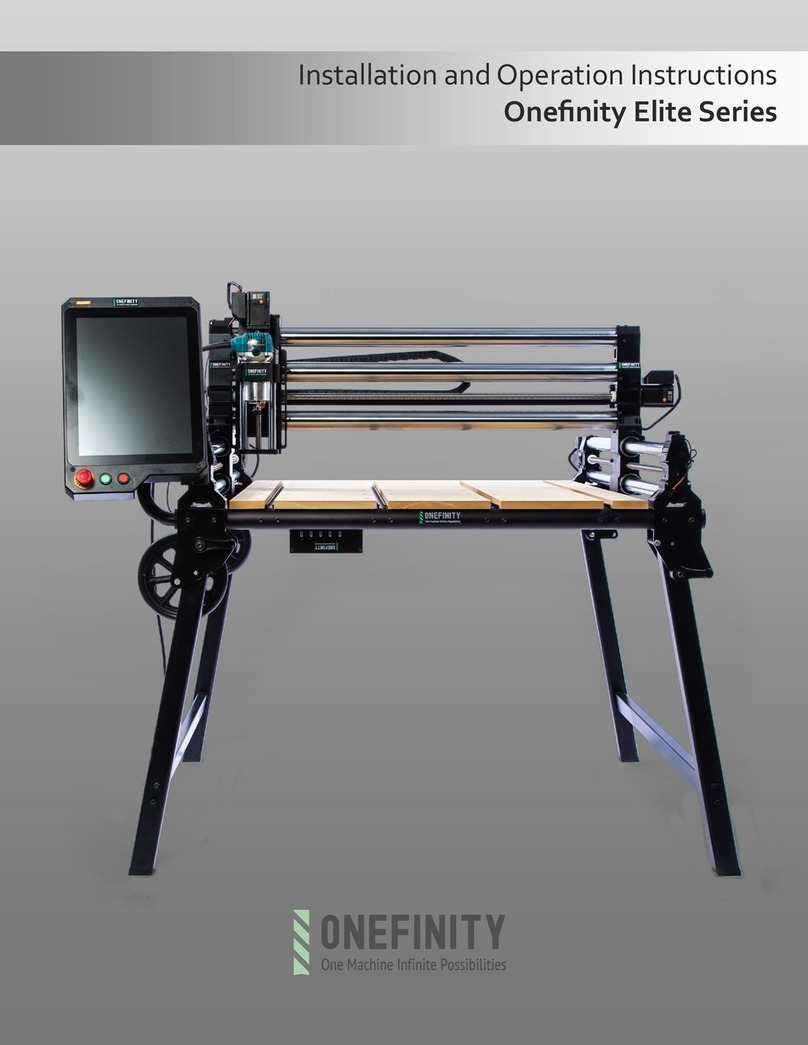
ONEFINITY
ONEFINITY Elite Series Installation and operation instruction
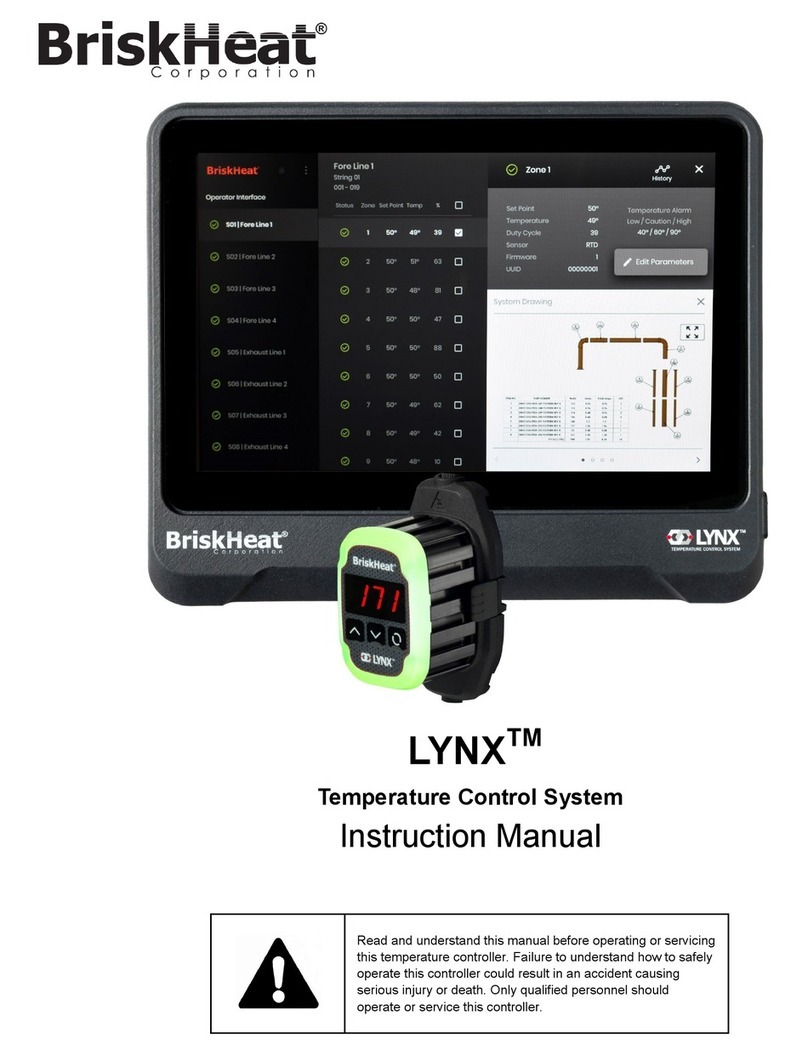
BriskHeat
BriskHeat LYNX instruction manual
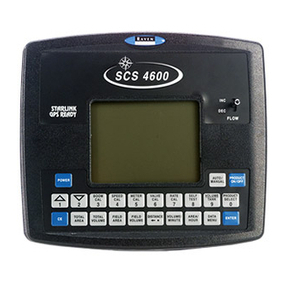
Raven
Raven SCS 4600 Operator's manual

Mitsubishi Electric
Mitsubishi Electric MEHITS MANAGER 3000+ Interface manual
